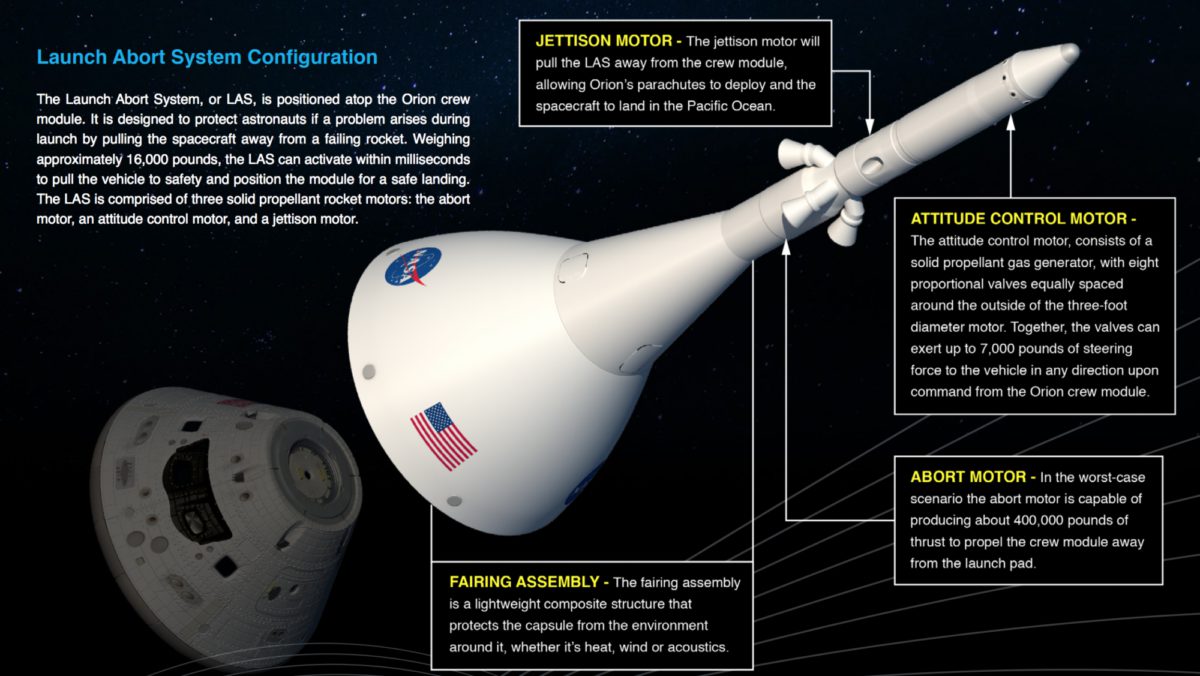Jason Davis • Jul 02, 2019
Orion Completes Critical In-Flight Abort Test
NASA's Orion spacecraft, which is slated to return humans to deep space, completed today a crucial test showing it can blast itself away from the Space Launch System (SLS) if the big rocket fails while attempting to fly to orbit.
Rather than sacrifice an entire SLS for the test, NASA attached an Orion test vehicle to the modified first stage of a retired Peacekeeper missile, and launched the duo at 07:00 EDT (11:00 UTC) from Space Launch Complex 46 at Cape Canaveral, Florida. Roughly 55 seconds into flight, as the vehicles hit a speed of about Mach 1.1—similar to the conditions during an SLS flight where Orion will experience the harshest aerodynamic forces—Orion’s launch escape tower activated and successfully blasted the capsule away.
NASA said the test appeared to go off without a hitch, which helps pave the way for Artemis 1, the inaugural uncrewed SLS next year. (The Government Accountability Office now believes that flight may slip to 2021.)
Orion Ascent Abort Test 2 video A fully functional Launch Abort System (LAS) with a test version of the Orion spacecraft attached launches on NASA’s Ascent Abort-2 (AA-2) test from launch pad 46 at Cape Canaveral Air Force Station in Florida on 2 July 2019.Video: NASA
Artemis, NASA's Moon landing program
Artemis is NASA's effort to send astronauts back to the Moon for the first time since the Apollo program.
Orion uses a disposable escape tower for emergency launch aborts. Escape towers attach to the top of a capsule and contain solid rocket motors that can quickly pull a capsule and its crew to safety should their rocket have a very bad day on the way to space. This basic design has been used by all crewed NASA vehicles except the Space Shuttle, and can also be found on Russia's Soyuz and China's Shenzhou vehicles.
The downside of the tower design is that it must be thrown away each flight, whereas newer capsules like SpaceX's Dragon have built-in, reusable escape thrusters. The upside of the tower design is safety and reliability; SpaceX’s unexplained loss of a Dragon capsule in April was related to the built-in escape system.
Orion's Launch Abort System, or LAS, consists of a payload fairing that covers the entire capsule and a tower with three separate rocket motors: an abort motor, an attitude control motor, and a jettison motor. During a nominal flight, once Orion is above most of Earth’s atmosphere, the jettison motor fires to pull the payload fairing and launch tower away from the vehicle.

But in the event of an emergency, all three motors are used. First, the abort motor fires with the payload fairing still attached, pulling Orion away from the Space Launch System. The motor provides an incredible amount of thrust in just a very short amount of time: In just 15 seconds, Orion will be more than 3 kilometers away from whatever is left of SLS. The crew will pull 7 Gs in the process. It certainly won’t be comfortable, but it’s survivable, and much better than the alternative.
At the same time, the attitude control motor keeps Orion from tumbling and guides it through a long, end-over-end flip, stopping when the vehicle is right-side-up again. The jettison motors fire just like they would during a nominal launch, pulling the payload fairing away, and Orion will be in free fall, just as if it is returning to Earth from space. Its parachute sequence kicks in, guiding the crew to a safe splashdown.
The purpose of today’s test was only to test the abort system, so this particular Orion capsule didn’t carry parachutes and crashed itself into the ocean. The capsule did, however, eject its data recorders, which descended under parachutes and will be retrieved for full analysis.
NASA already completed an end-to-end pad abort test in 2010 at White Sands, New Mexico, simulating how the spacecraft would blast itself to safety directly off the launch pad. Orion has also completed its eight parachute qualification tests, and many more parachute development tests before that. The service module for the first Orion capsule, which is scheduled to make a test flight to the Moon in 2020, completed acoustic tests in May at Kennedy Space Center.
The Time is Now.
As a Planetary Defender, you’re part of our mission to decrease the risk of Earth being hit by an asteroid or comet.
Donate Today

 Explore Worlds
Explore Worlds Find Life
Find Life Defend Earth
Defend Earth


